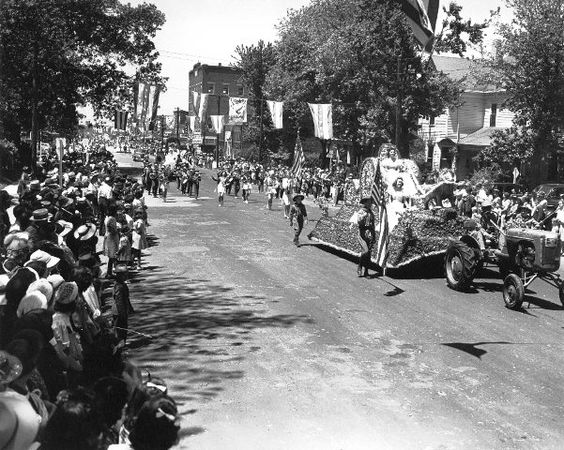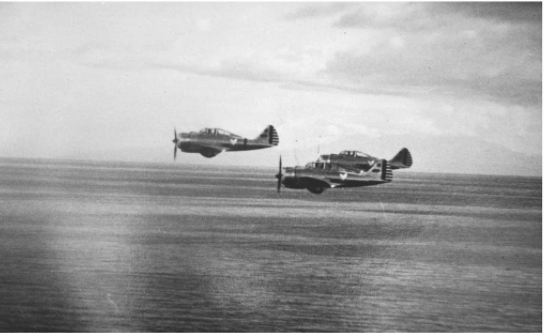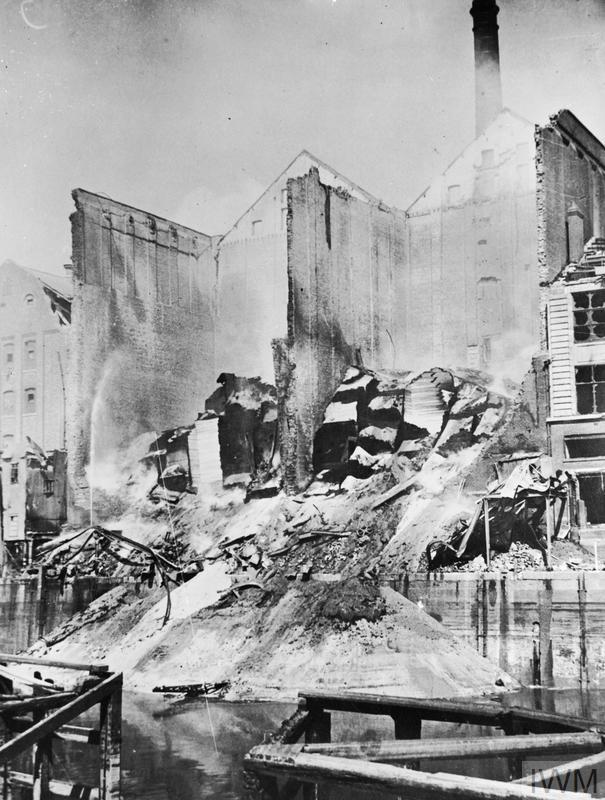Thursday 8 May 1941
 |
| Merseyside Bomb Damage, Stanley Road Bridge, Bootle, May 1941. |
However, now it is the second week of May 1941, and things begin to change. Tonight, RAF Bomber Command launches a massive 359-aircraft raid on Hamburg, Bremen and diversionary targets, its largest effort of the war to date (317 against Hamburg and Bremen alone, with 19 sent against the Kiel Canal). The Luftwaffe gives up on Liverpool - right when the port is reeling - and shifts to the Rolls Royce works at Derby (which, of course, manufactures the all-important aircraft engines that some say are war-winning material). The British institute radio countermeasures that they have been refining for months, and this appears to have the desired effect of confusing the German navigators. Bombs fall all across the countryside in the Peak District, Nottingham, the agricultural Vale of Belvoir and nearby locations.
The Luftwaffe, which finally has figured out how to make its city raids pay real dividends by destroying port infrastructure, now shifts back to attacking 20 airfields during the night. While much damage is still being wrought in England, the air battle never again will be as one-sided in favor of the Luftwaffe as it was from 1-7 May 1941.
The Luftwaffe raids the Clyde, setting back construction of destroyer HMS Pakenham and monitor Roberts. An attack on the Tyne damages destroyers Vivacious and Whaddon, but nobody is aboard them because they are under repair.
The Luftwaffe raids Hull for the second consecutive (and last) night. The military helps with rescue work. The Germans hit Alexandra Dock and sink:
- 89-ton barge Delite
- 91-ton barge Ladore
- 48-ton barge Whitakers No. II
- 38-ton ketch (lighter) Welcome Home
Nottingham suffers extensive damage in what comes to be called, appropriately enough, the Nottingham Blitz. Fortunately, the city government has built numerous shelters. The British successfully jam the X-Gerät beams being used to guide the Luftwaffe bombers, and most of their bombs fall harmlessly in the moors. In addition, a Starfish decoy (fires lit intentionally in the countryside to misdirect Luftwaffe attackers) confuses some of the German planes, and they drop their bombs harmlessly near Cropwell Butler in the Vale of Belvoir. However, there are over 100 bombers in this raid, which is directed at the Rolls Royce works. Dropping incendiaries, they start 12 serious fires, 40 major fires, and 42 medium fires.
Damage to Liverpool continues to be assessed. In the final raid on the 7th, which crept into the early hours of the 8th, the following ships were hit:
- 4969-ton British freighter Marton (sunk)
- 143-ton barge Rose (sunk)
- 3079-ton freighter Trentino (sunk)
- 127-ton barge Burmah (sunk)
- 591-ton freighter Royal Daffodil (damaged)
- 2544-ton Finnish freighter Annenberg (damaged)
- 2902-ton Belgian freighter Leopold II (damaged)
- 1376-ton Norwegian freighter Stromboli (damaged)
- 652-ton British crane Hercules (damaged).
Kommodore Moelders of JG 51 claims a Spitfire from RAF No. 92 Squadron in his brand new Bf 109F. It is his third victory in the last few days in the new version of the Reich's front-line fighter, a good omen for future use of the plane by the rest of the Luftwaffe.
 |
| "Arab Legionnaires guard the landing ground at H4 pumping station on the Iraq Petroleum Company pipeline in Transjordan, as Gloster Gladiators of No. 94 Squadron RAF Detachment refuel during their journey from Ismailia, Egypt, to reinforce the besieged garrison at Habbaniyah, Iraq. On arrival at Habbaniyah, these aircraft formed No. 1 Flight of 'A' Squadron for operations against the Iraqi rebels." 8 May 1941. © IWM (CM 774). |
I must have the advice of the Staffs upon the Syrian business available for Cabinet this morning. A supreme effort must be made to prevent the Germans getting a foothold in Syria with small forces and then using Syria as a jumping-off ground for the air domination of Iraq and Persia. ... We ought to help in every way without minding what happens at Vichy.While it is not clear what Churchill means by "a supreme effort" against Syria, that is the subject of the evening's War Cabinet meeting.
The British and Transjordanian forces crossing the desert from Palestine arrive at Rutbah Fort. They find it occupied by Iraqi forces under Rashid Ali, but the defenders are mostly just local policemen. The RAF sends four Blenheim bombers of No. 203 Squadron to bomb the fort while the British troops wait outside.
At the port of Basra, the Indian 10th Infantry Division continues fighting its way out of the port and consolidates its capture of Ashar.
East African Campaign: After an opening attack by Indian troops at Amba Alagi that proved unsuccessful, fighting largely has died down at the Italian stronghold of Amba Alagi. An Indian 9th Infantry Brigade diversionary attack through the Falagi Pass to the east makes some progress and essentially clears the pass. However, the Italians counterattack and recover Centre and Khaki Hills. The British Army has reinforcements on the march only days away.
 |
| HMS Sickle (P224). Laid down: 8 May 1941. Launched: 27 August 1942. Commissioned: 1 December 1942. Fate: Sunk June 1944. |
The Luftwaffe bombs and sinks 521-ton anti-submarine yacht HMY Viva II about 13 miles west of Trevose Head. There are 22 deaths and ten survivors.
The Luftwaffe bombs and sinks 93-ton naval drifter Uberty at Lowestoft. There are 13 deaths.
Royal Navy 79-ton drifter Thistle V hits a mine off Lowestoft and sinks. There are nine deaths and one survivor.
British 16-ton smack Thistle hits a mine and sinks off Clacton-on-Sea. Everyone survives.
Spanish 106-ton fishing trawler Luis Puebla hits a mine and sinks 160 miles northeast of Gijon. All nine aboard the ship survive.
Royal Navy patrol sloop Puffin has an accident with depth charges during exercises off the Humber. It requires two days of repairs.
Convoy OB 320 departs from Liverpool.
Royal Navy submarine HMS Sickle is laid down.
U-569 (Kptlt. Hans-Peter Hinsch) is commissioned, U-515 is laid down.
 |
| German raider Pinguin (Ship No. 33), sunk 8 May 1941. |
British cruiser HMS Cornwall, which had been 500 nautical miles (930 km) to the south of Pinguin, heads north and intercepts the German raider 400 miles off Somaliland. The Pinguin spots the Royal Navy ship first and tries to run away to the southwest at flank speed, but the Cornwall's Supermarine Walrus search plane spots the fleeing ship. The Cornwall is cautious: there are a lot of innocent ships in the vicinity, and Cmdr. Ernst-Felix Krüder of the Pinguin has disguised his ship carefully as Norwegian freighter Tamerlane. After returning to the Cornwall, the Walrus returns for a closer look. Once again the Walrus returns to the Cornwall, but then the decision is made to look over the suspicious ship a third time, and the captain of the Cornwall decides to take a look himself.
 |
| Ernst-Felix Krüder (6 December 1897 – 8 May 1941). |
There are 60 survivors of the Pinguin (Krüder goes down with his ship), and 24 of 238 prisoners held on the ship survive. In total, 214 prisoners and 341 crew of the Pinguin perish in the encounter. In total, during its 59,000-mile cruise, the Pinguin sank or captured 28 ships for a total of 136,642 gross register tons, and it has laid mines that have sunk an additional four ships of 18,068 tons. The biggest prize of all was the Pinguin's capture of the entire Norwegian Antarctic Whaling fleet, including two factory ships, eleven whalers, and a tanker. That is all over now, though, and the Pinguin has the additional distinction of becoming the first German raider to be sunk.
Minesweeper HMAS Warrnambool is launched.
 |
| Warrnambool slides down the slipway at Mort's Dock, Sydney, 8 May 1941. |
General Friedrich Paulus, who has been in North Africa on an "inspection tour" since being sent there on 24 April, flies to Rome for a meeting with Benito Mussolini. This leaves General Rommel in sole command of the Afrika Korps. Paulus is of the view, shared (perhaps not coincidentally) by his superiors at OKW, that Rommel is too headstrong and prone to over-extending his forces. However, neither Mussolini nor Hitler are dissatisfied with Rommel's handling of the Afrika Korps, so they do not act on Paulus' recommendations.
Winston Churchill keeps the pressure on his staff regarding the Takoradi route, which shuttles planes from the west coast of Africa to Cairo. He tells the War Cabinet that "greater efforts" are necessary, and that "It was evident that inadequate steps had been taken to secure American aid in erecting American aircraft."
Royal Navy submarine HMS Truant is proceeding from Malta to Gibraltar for repairs when it spots and captures 1775 ton French freighter Gallium. The Truant takes the Gallium as a prize and continues with it toward Gibraltar. However, the Gallium has alerted the Vichy French of its situation, and the French decide to dispatch ships from Oran to recover it. This continues the very murky pattern of naval incidents between the Royal and French Navies during this period.
 |
| Bf 109E3B of 9.JG27 Brown 8, Gela, Sicily, May 1941. |
Royal Navy submarine Cachalot arrives in Malta from Alexandria. It carries badly needed supplies. The bombing has become so regular at the island that the government there decides to relocate facilities underground. There is only one problem: everyone is in the military and there aren't enough miners to do the job. Governor Dobbie requests that miners be sent from Gibraltar for the job. Dobbie also bans the dissemination of all printed material, including newspapers such as the Government Gazette.
German/Spanish Relations: German Foreign Minister Ribbentrop signs an agreement with his Spanish counterpart by which Spanish workers will head north to work in German war plants.
 |
| The Strawberry Festival Parade in Humboldt, Tennessee. May 8, 1941. |
Our shipping losses for April amount to just under 500,000 tons sunk and 285,000 damaged. Of tonnage lost, over 300,000 were incurred in the Atlantic and the rest in the Mediterranean fighting. Besides the loss in ships sunk and damaged at sea we are losing very heavily in the bombing of our western ports when cargoes are destroyed or damaged.Churchill adds that he will publish the figures on "this very bad month" on 15 May.
Australian/US Relations: Having met with Malcolm Macdonald in the morning, Australian Prime Minister Robert Menzies boards a train from Ottawa to Toronto and then flies down to Washington. He notes in his diary that "the French Canadians... are OK," an allusion to worries that they may choose to align with Vichy France rather than the Allies.
British Military: Vice Admiral L. E. Holland, CB, formerly Vice Admiral 18th Cruiser Squadron, is named temporary commander of the 18th Cruiser Squadron, replacing Vice-Admiral W.J. Whitworth. Holland will raise his flag on HMS Hood on 12 May.
 |
| Bomb damage at the bottom of Friar Lane, Nottingham, the night of 8-9 May 1941 (Photo courtesy of John Beckett, 1990. Book of Nottingham. 1st Edition. Barracuda Bks). |
It is not a popular choice - Mussolini can't stand the prince - but he is acceptable to the King and everyone else, so that is that. There's only one problem: nobody can find the prince. The rest of the day is spent searching for the lucky 41-year-old to tell him he has just been made king of the independent State of Croatia. Prince Aimone, however, is hiding out with his mistress and, quite frankly, doesn't want to be found. As Ciano writes in his diary:
When we looked for him, to give him the news, we managed to find him, only after twenty-four hours, in a Milan Hotel, where he was hiding in the company of a young girl.When finally found, the prince laughs it off and says his proposed royal name, Tomislav II, sounds like "the name of a ruler in an operetta or that of a music-hall comedian." Finally, the King himself has to announce the selection for Prince Aimone to realize it is a serious proposition and accept the decision.
 |
| P-35As of the 17th Pursuit Squadron, photo taken from USAT Washington as it arrives in Manila on 8 May 1941 (Walter Hinkle via Clyde Childress). |
Serbia: The Sanski Most revolt continues, and the Germans respond today with extreme force. General Rudolf Sintzenich sends the 3rd Battalion of the 436 Infantry Regiment by train from Banja Luka to Sanksi Most via Prijedor. Other troops arrive from Bosanski Novi and Prijedor. The German counterattack opens at 8 a.m., and by 11 a.m. the Serb revolt is crushed. The Wehrmacht troops sweep the area of revolt with the local Ustaše troops, with most of the rebels throwing down their weapons and surrendering but dozens perishing in the fighting. The Germans have difficulty distinguishing rebels from the rest of the population, so they wind up capturing many civilians who had nothing to do with the fighting. Reprisal executions are planned for the 9th.
China: The Japanese offensive by the North China Front Army called the Battle of Southern Shansi (Chungyuan Operation) gathers steam. They attack Tungfeng and capture Tsiyuan, Menghsien, Fulochen, and Yuanchu. The Chinese Nationalist forces in the area are in trouble and call on nearby Communist forces for help, but the communists are slow to respond due to previous incidents with the Kuomintang.
 |
| A Marmon-Herrington Mk II armored car armed with an Italian Breda 20mm gun, near Tobruk, 8 May 1941." © IWM (E 2872). |
May 1941
May 1, 1941: British Hold Tobruk
May 2, 1941: Anglo-Iraq War
May 3, 1941: Liverpool Hammered
May 4, 1941: Hitler Victory Speech
May 5, 1941: Patriots Day
May 6, 1941: Stalin In Command
May 7, 1941: May Blitz
May 8, 1941: Pinguin Sunk
May 9, 1941: U-110 Captured
May 10, 1941: Hess Flies Into History
May 11, 1941: The Hess Peace Plan
May 12, 1941: Tiger Arrives Safely
May 13, 1941: Keitel's Illegal Order
May 14, 1941: Holocaust in Paris
May 15, 1941: Operation Brevity
May 16, 1941: Blitz Ends
May 17, 1941: Habbaniya Relieved
May 18, 1941: Croatia Partitioned
May 19, 1941: Bismarck at Sea
May 20, 1941: Invasion of Crete
May 21, 1941: Robin Moore Sinking
May 22, 1941: Royal Navy Destruction Off Crete
May 23, 1941: Crete Must Be Won
May 24, 1941: Bismarck Sinks Hood
May 25, 1941: Lütjens' Brilliant Maneuver
May 26, 1941: Bismarck Stopped
May 27, 1941: Bismarck Sunk
May 28, 1941: Crete Lost
May 29, 1941: Royal Navy Mauled Off Crete
May 30, 1941: Sorge Warns, Stalin Ignores
May 31, 1941: British Take Baghdad
2020







